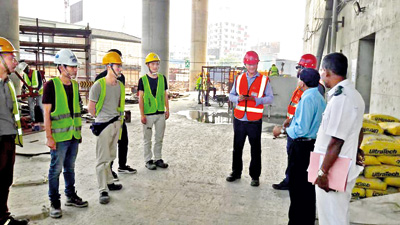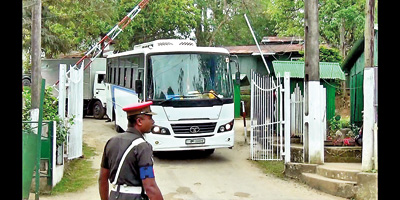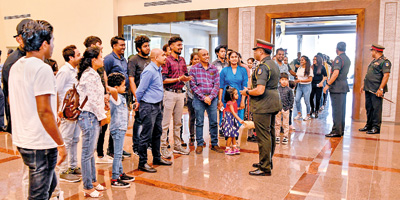News
State & pvt sectors to gear up with tests for new virus
As the number of people hit by the new coron3entre Wuhan in the Hubei Province of China grew rapidly, Sri Lanka maintained its ‘one-imported case’ status.

Health officials visiting construction sites to brief Chinese workers on measures taken by the govt.
The new coronavirus disease has now been named COVID-19 by the World Health Organisation (WHO) and the virus as Severe Acute Respiratory Syndrome coronavirus 2 (SARS-CoV-2) by the International Committee on Taxonomy of Viruses.
Moves are underway for the clinical laboratories of the Anuradhapura, Kandy and Karapitiya Teaching Hospitals to expand their facilities to conduct the tests for COVID-19, the Sunday Times learns.
While these tests are to be performed as a back-up support to the Medical Research Institute (MRI) which is currently the only laboratory handling these tests to determine whether a person is positive or negative, the Sunday Times understands that some universities and private hospitals are also in the process of equipping their laboratories to carry out these tests.
With regard to the infection spread by the new coronavirus worldwide, Consultant Physician Dr. Ananda Wijewickrama attached to the National Institute of Infectious Diseases (NIID), Angoda, said: “We have the facilities and capability to deal with the virus,” pointing out that if, however, it comes in the scale of what is happening in China, no country would be able to cope.
The NIID is currently having three suspected cases (1 Chinese and 2 locals) in addition to the Chinese woman tourist who tested positive on January 27 and is now cured and awaiting departure to China.
The Sunday Times learns that altogether there are 8 suspected cases under observation in the 12 designated hospitals.
Reiterating that it is a new virus and there is still limited knowledge, Dr. Wijewickrama said that Sri Lanka is following the precautions recommended by the WHO that two PCR tests need to be negative for a patient to be cleared from illness.
“We are being very cautious until research by many countries gives us some definitive answers,” he said.
This was as the WHO risk assessment was ‘Very High’ for China; ‘High’ for the region; and ‘High’ globally and WHO Executive Director of the Health Emergencies Programme, Dr. Michael Ryan on February 13 told a media briefing in Geneva at the WHO Headquarters that outside China, there are 447 cases from 24 other countries and now two deaths. In addition to the death in the Philippines, there is now one more in Japan.
“We need to be very careful when interpreting any extremes. Be it in incubation period, be it in daily numbers, we must take all numbers into account, we must look at all numbers seriously but we also must try and interpret what those numbers mean and not react directly to the number itself,” he cautioned.
Pointing out that “we don’t know the dynamics of the new virus”, Clinical Virologist Dr. Saranga Sumathipala who is attached to the Anuradhapura Teaching Hospital told the Sunday Times that usually in any viral disease, once it starts spreading, there is a rise to a peak and then a decline. Thereafter, it can either get established or disappear from the environment.
“The closest genetic relative of this new virus seems to be SARS, that’s why this virus becomes the SARS-CoV-2, with the 2002 virus being SARS-CoV. The origins of this virus are still being determined with the focus being on the bat (Chinese horse-shoe bat) or the pangolin,” he said, adding that the virus seems to be less active in warmer climates.
The Sunday Times, meanwhile, learns that arrivals at the Bandaranaike International Airport (BIA), Katunayake, have dropped and this was confirmed by the Chairman of the Airport and Aviation Services (Sri Lanka) Ltd, Major General (Rtd.) G.A. Chandrasiri who said that “there is a drop according to my perspective. There is definitely a drop in the Chinese passengers. Other than that all routine flights are taking place”.
When asked by the Sunday Times for specific numbers, he said that he did not have that much detail, adding that with the BIA stopping visitors coming in to meet arrivals, the airport is calm and quiet.
The Media Spokesperson of the Department of Immigration and Emigration, B.G.G. Milinda, meanwhile, said that 23,397 Chinese arrived in the country between January 1 and February 8, this year.
In 2019, there had been 187,148 arrivals from China in Sri Lanka, but there was no monthly breakdown.
The website of the Sri Lanka Tourism Development Authority (SLTDA) indicated that in January 2019 there had been 26,414 tourists from China, while in January this year, the figure was 22,363, indicating a drop of over 4,000.
Several attempts to contact the SLTDA to find out the figures for the first two weeks of February failed, with personnel transferring the calls hither and thither.
With regard to the ports, Chief Manager of Communications at the Sri Lanka Ports Authority (SLPA), Nalin Aponso, said precautions were being taken to make sure that passengers and crew members arriving on ships would not bring the virus into Sri Lanka through any port including Colombo.
“The medical records of the passengers and crew of the vessels are obtained through the ships’ captains. If there is a patient or a suspected case they would be sent to a specified hospital,” he said.
Crew members and passengers are examined thoroughly before being sent out of the port, added SLPA’s Additional Managing Director Upali De Zoysa.
Mr. Aponso said that the Phoenix cruise-liner ‘Artania’ with 1,200 passengers and 420 crew members arrived on Thursday from Germany through Maldives at 6 a.m. and departed at 8 p.m. The next one, the Celebrity cruise liner’s ‘Celebrity’ is due at the Colombo harbour from Dubai-Singapore-Thailand next Friday with 2,449 passengers and 1,000 crew members.
Many health and other sources were of the view that Sri Lanka should be extra alert when workers and tourists from China return to the country, as they could bring back the virus.
Keeping the virus at bay is the best measure, they said.
Echoing these views, Consultant Paediatrician Dr. LakKumar Fernando attached to the Negombo Hospital said that the world is “still studying” this new virus and there may be much to learn about it.
Even though there are initial reports that the incubation period of the virus is 1-14 days, scientists are experimenting yet and may find that it goes beyond 14 days.
He, like many doctors that the Sunday Times spoke to, looked at Influenza A and B which make a large number of people ill.
Looking closely at transmissibility of the new coronavirus, which seems to be spreading at a much faster rate than Influenza A and B and SARS, he urged that the best measure would be to prevent the new coronavirus from coming into the country.
Otherwise, there would be “catastrophic” consequences, he said, comparing Sri Lanka with China which even with all its resources has not been able to stop the inexorable march of the virus.
He said the need of the hour, without barring people from coming into the country or placing travel bans, should be strong moves not only to discourage visitors from the Far East including China but also give out specific travel advisories in Sri Lanka not to go to affected countries including the Far East unless there is an unavoidable need.
There should be an efficient tracking system of all those who do go out of the country and return and also requests from the health authorities to them to engage in self-quarantine, he said.
Much logic and sense were obvious in these suggestions with the world experiencing a spread of the virus and also references to ‘super-spreaders’.
Many health sources who declined to be quoted also spoke of a few of the 12 designated hospitals not being as efficient as a majority of them. The designated hospitals are the NIID, the Kandy National Hospital, the Kalubowila, Karapitiya, Anuradhapura, Jaffna, Kurunegala and Batticaloa Teaching Hospitals, and the Gampaha, Negombo, Ratnapura and Badulla Hospitals.
Some of these hospitals don’t have adequate facilities, they alleged, pointing out that in isolation wards there was a necessity for the air-conditioning to be like those in operating theatres where the air inside the ward is not released to the external environment. Such wards, if in popular hospitals, also need to be away from crowded areas.
Stressing that it is not a criticism of the system as the health authorities seem to be making a major effort to do everything possible, they said that a detailed checklist needs to be ticked off constantly to ensure that Sri Lanka is able to deal with not only this coronavirus but any other, as these instances could be regular occurrences in a world which has turned into a global village.
| Tea at Army Hqrs before heading for home | |
| The 33 Sri Lankans from Wuhan, China, who were kept in quarantine at Diyatalawa have returned home to their loved ones.They met Army Commander Lt. Gen. Shavendra Silva and several high level officials from all fields involved in bringing them home and looking after them, at the Army Headquarters in Battaramulla on Friday afternoon, had tea and left for home, said the Director of Media at Army Headquarters, Brigadier Chandana Wickramasinghe.
 Going home: The group leaving Diyatalawa camp (inset) and meeting officials at the tea party at the Army Headquarters (top). Pix by Palitha Ariyawansa |






